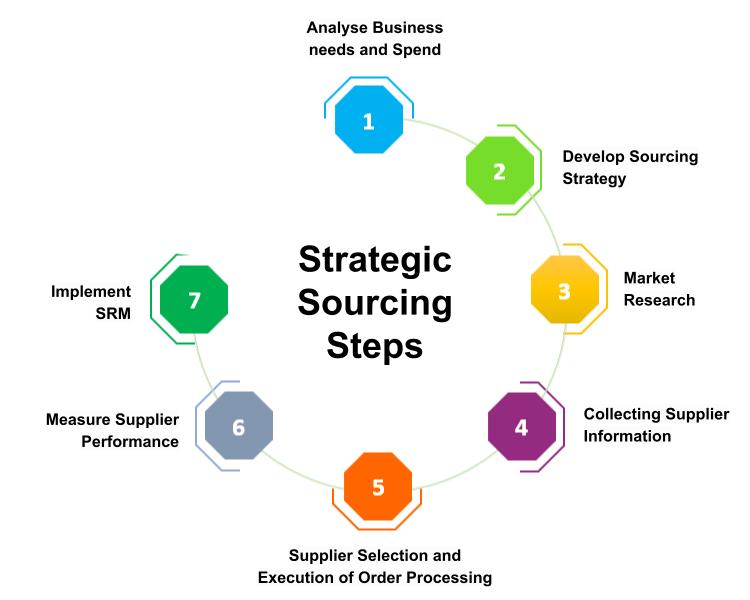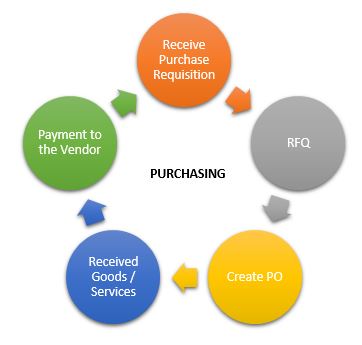Strategic sourcing is an approach to Supply Chain Management that analyses the
total cost of ownership (TCO). Supply Chain is transforming into a more
strategic function that is aligned to organizational goals. Strategic sourcing
is an approach that validates the route of information collected and used to
an organization to boost purchasing power.
The boom in the adaption of digital transformation is forcing sourcing process
to evolve & it’s aim for continuous improvement and re-evaluation of the
purchasing activities.
How it works
Procurement department use strategic sourcing process to create values that
contributes to long term business goal. The process begins with analysing
business requirements and historical spending data followed by other steps.
Procurement Vs Tactical Sourcing Vs Strategic Sourcing
-
Procurement: Procurement tends to be broader and more
proactive, with some focus on strategic matters, as compared with the
typical implementation of the purchasing concept. Procurement is the process
of planning, sourcing, contract award and management which needs to fulfil
company’s business model. -
Tactical Sourcing: It’s involving a short-term and reactive
approach towards managing the sourcing activities. -
Strategic Sourcing: It’s containing a long-term and
proactive sourcing activities. Suppliers as become valued partner and this
process able to build sustainable & collaborative relationship between
buyer and seller.
Key Benefits of a Sourcing Strategy
Strategic sourcing streamline business operations to make them cost effective.
It is important to understand its benefits to adopt strategic sourcing.
Strategic Sourcing Steps
Understanding the benefit of strategic sourcing, it would be appealing to
implement a sourcing strategy for your organisation. It has 7 steps, which is
mentioned below:
1. Analyse Business needs and spend
To initiate the
strategic sourcing process, identify the requirements and key spend areas and
categorize them into critical and non-critical. If required, further
categorization can be done such as direct & indirect spend, domestic spend
and international spend, etc.
2. Develop Sourcing Strategy
In this step you need to
map the business requirement with spending category and develop communication
workflow between procurement & stakeholders to have clear visibility on
sourcing activities / projects.
3. Market Research
Supplier market research is a very
important step in strategic sourcing process. You need to execute in-depth
market analysis of the past, current and future revenue or market share of the
suppliers and industrial performance along with risk & opportunities.
4. Collecting Supplier Information
This is a formal process for collecting data from various potential suppliers.
Data can be a form of RFI & RFP or RFQ. Ensure that you clearly state your
business requirements so that suppliers can submit correct information.
Supplier selection can be done based on it and a master list to be prepared to
store information received from the suppliers.
5. Supplier Selection and Execution of Order Processing
Your procurement process must have a vendor selection check list. Apply vendor
selection process to shortlist the suppliers from your master list, if
supplier not available in your master list, develop new. After supplier
selection for the relevant spend categories, the ordering process starts to
on-board the supplier in your organization.
6. Measure and Monitor – Supplier Performance
Supplier performance management is a business practice that is used to measure
and monitor the performance of a supplier. Supplier performance measure
includes on time delivery, specification, price, delivery, etc. It is
important to check in periodic tracking of supplier performance which can help
organization understand supply risks and design strategies to mitigate supply
chain disruptions and reduce cost.
7. Implement Supplier Relationship Management
Supplier
Relationship Management (SRM) in the the strategic sourcing process
collaborate between business and suppliers. SRM tool is highly effective and
adds more values to the organizations. Buyer and supplier participate in
building propositions and innovative strategies that optimize the sourcing
needs of the organization.
Automation of Strategic Sourcing
Organizations are adopting eSourcing in order to streamline & simplify
their procurement and strategic sourcing activities. It helps to overcome the
difficulties of manually managing supplier information, proposal and other
sourcing activities. Following key factors driving use of eSourcing automation
in your organization.
- Data Visibility
Strategic sourcing tools produce useful and insightful data on spending
activities, supplier performance, top suppliers, top categories, supply risk
assessment, etc. The data management can be centralized, and which increases
the visibility. The data presented in the form of reports or dashboard which
help the management to take the quick sourcing decision.
- Spend Category Visibility
Automaton of eSourcing tools helps to identify and categorize the various
spend in an organization across business units. It enables an organization to
streamline and control the spend activities.
- Risk Assessment
eSourcing tools enables an organization to identify risks probability that
block supply chain which helps sourcing team to act accordingly to mitigate
the supply risks and improve compliances.
- Accountability
Workflow, approval matrix, user access limitation can be mapped in eSourcing
tool and display the sourcing activities accordingly. It brings transparency
on data processing which increases accountability and higher compliance by all
the users assigned in the sourcing projects.
Strategic Sourcing Consulting Firms
Organizations are partnering with sourcing consulting firm to help
navigate growing supply chain disruptions and overcome the challenges. Here is
list of global consulting firms.
- Infosys
- Accenture
- IBM
- Capgemini
- SAP Ariba
- GEP
- KPMG
- EY
- Deloitte
- Gartner
- iDealx
Related readings:
Cross Function Collaboration
|
Purchasing Process
|
Spend Analysis Framework
Summary
In this post, we have discussed about strategic sourcing, its
definition, how its differ from tactical sourcing, benefit of implementation,
sourcing steps and automation. Business can utilize the power of automation to
make strategic sourcing high performing, data-driven, and cost effective.


.jpg)


